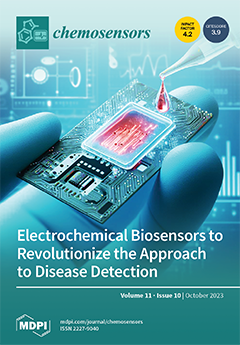Hydrogen peroxide is essential for biological processes and normally occurs in low concentrations in living organisms. However, exposure of plants to biotic and abiotic stressors can disrupt their defense mechanisms, resulting in oxidative stress with elevated H
2O
2 levels. This oxidative
[...] Read more.
Hydrogen peroxide is essential for biological processes and normally occurs in low concentrations in living organisms. However, exposure of plants to biotic and abiotic stressors can disrupt their defense mechanisms, resulting in oxidative stress with elevated H
2O
2 levels. This oxidative stress can damage cell membranes, impair photosynthesis, and hinder crucial plant functions. The primary focus of this article is to investigate the effects of salt and herbicide stress factors on the growth of rye samples. For precise quantification of the released H
2O
2 concentration caused by these stress factors, a non-enzymatic electrochemical sensor was developed, employing nanostructured CuO and Co
3O
4 oxides. Nanostructured electrodes exhibit high sensitivity and selectivity towards H
2O
2, making them suitable for detecting H
2O
2 in real samples with complex compositions. Rye samples exposed to NaCl- and glyphosate-induced stress demonstrated notable concentrations of released H
2O
2, displaying an increase of up to 30% compared to the control sample. Moreover, optical absorption measurements revealed a substantial decrease in chlorophyll concentration (up to 35% compared to the control group) in rye samples where elevated H
2O
2 levels were detected through electrochemical methods. These findings provide further evidence of the harmful effects of elevated H
2O
2 concentrations on plant vital functions.
Full article





